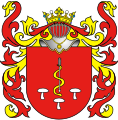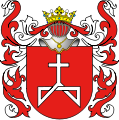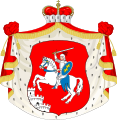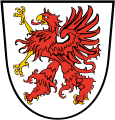
A | B | C | D | E | F | G | H | CH | I | J | K | L | M | N | O | P | Q | R | S | T | U | V | W | X | Y | Z | 0 | 1 | 2 | 3 | 4 | 5 | 6 | 7 | 8 | 9
Polish heraldry is typical to the Polish nobility/szlachta, which has its origins in Middle Ages knights/warriors clans that provided military support to the king, dukes or overlords.
Exceptions apart, all Polish families belonging to the same noble rod/clan used/use the same coat of arms. The Polish original word herb makes reference to the clan as well to the coat of arms at the same time.
Polish heraldry
Traditionally, Polish noble families/rody refer to people that share common roots or consanguinity; later, it also included further kinship. Some think the Polish clan does not mean consanguinity nor territoriality, as do the Scottish clan, but only membership in the same knight/warrior group (or a brotherhood of knights). For that reason, there are hundreds of different families in the same clan and all of them were/are entitled to use the same coat of arms. However, in regards to consanguinity, the matter is far from settled, and the question matters because of historiographical concern to discover the origins of the privileged status by membership in the knights' clan. In the year 1244, Bolesław, Duke of Masovia, identified members of the knights' clan as members of a genealogia:
"I received my good servitors from the land of Poland, and from the clan called Jelito, with my well-disposed knowledge and the cry , , the godło, Nagody, and I established them in the said land of mine, Masovia, ."
The documentation regarding Raciborz and Albert's tenure is the earliest surviving of the use of the clan name and cry defining the honorable status of Polish knights. The names of knightly genealogiae only came to be associated with heraldic devices later in the Middle Ages and in the early modern period. The Polish clan name and cry ritualized the ius militare, i.e., the power to command an army; and they had been used some time before 1244 to define knightly status.[1] Nevertheless, in daily life, (from the 17th to the 20th century), the sense of belonging to a family predominated. This is indicated by the organization of most of Polish armorial, which are arranged by specific families and not by coat of arms.
It is known that a sense of belonging and attachment to the clan crest lineage existed in the old Polish consciousness and had survived from the Middle Ages, but it was probably more ceremonial and symbolic than "everyday".
Especially since there were fairly frequent instances, particularly among the poorer nobility in the 19th century, of accidentally (and sometimes deliberately) identifying themselves with various coat of arms to the heraldry offices of the partitioning countries. In this way, members of a single family sometimes formally became members of various coats of arms.[2] Also in those times, magnate families and some middle landowners families obtained titles (prince, count, baron) and their own coats of arms, (variations of their original herb), from the partitioning monarchies, the French empire, the pope and other kingdoms.[3]
Polish coat of arms have an own name, usually coming from its old war cry or the drawing.
List
The coats of arms are listed under their most popular name, which is followed by their alternate names in brackets.
A
- Abdank (Awdaniec, Abdanek, Białkotka, Buczacki, Habdank, Łękawa, Skuba, Wiszowaty)
- Abgarowicz
- Achinger (Aichinger, Ajchigier)
- Agryppa
- Aksak
- Alabanda (Alba-luna, Bielina, Koniowaszyja)
- Alemani (Alameni, Allemani)
- Allan
- Amadej (Amadejowa, Hemadejowa, Orłek bez ogona)
- Antoniewicz (Bołoz)
- Awdaniec
- Azewoja
- Azulewicz
- Ancuta
B
- Bajbuza
- Batorsag (Own coat of arms, originating from Hungary)
- Bełty
- Bes
- Beztrwogi
- Białynia (Bialina, Bielina)
- Biberstein (Bibersztein, Bibersztajn, Bibersztyn, Bieberstein, Momot)
- Bielawa
- Bielina
- Bieńkowski (Korwin variation)
- Biliński (Sas variation)Bielecki
- Bogdanowicz
- Bogoria or Bogorya
- Bogusz
- Bojcza (Boycza, Modzele, Piasnicza)
- Bończa (Głoworożec, Jednorożec, Tomaszewski)
- Boreyko
- Bożawola
- Bożezdarz
- Brama
- Brochwicz (Jeleń, Opole)
- Brodzic
- Bronic (Jelec, Łopot)
- Bronisław
- Brzuska
C
- Casafranca (Kazafranka)
- Celejów
- Chlibkiewicz
- Cholewa
- Chłędowski
- Chomąto (Pantera)
- Choryński (Chory, Chorynski, Chorinský, Chorinsky, Chorinská)
- Chyliński
- Cielątkowa (Kucza)
- Cieleski
- Ciężosił
- Ciołek (Biała)
- Czarlinski coat of arms (Sowa)
- Czartoryski
- Czarnowron (Ślepowron variation Czarnowron)
- Czewoja (Czawa, Łzawia, Łzawa)
D
- Dąb (Dub, Ehler, Żelechy)
- Dąbrowa
- Dąbrowski (Panna)
- Dąbrowski I
- Dębno (Sędowojna)
- Denhof (Denhoff)
- Deszpot
- Dobrostanski
- Doliwa (Krzucki ie Kruski)
- Dołęga
- Domeyko coat of arms
- Drogomir
- Drogosław
- Druck (Drucki Książę)
- Dryja (Drya, Mutina)
- Drzewica
- Działosza
E
F
G
- Garczyński (Sas variation)
- Gąska (Budzisz, Paparona)
- Giejsz
- Geysztor
- Gierałt (Ciecierza, Cietrzew, Osmoróg, Rogów)
- Ginwiłł (Ginwił)
- Glaubicz (Carpio, Glajbicz, Glaubitz, Glubos, Gluboz, Gloubus, Glawbz, Karp)
- Gliński
- Gniazdowski
- Godziemba (Godzięba, Godzięby)
- Goły (Goły, Goły)
- Gondek (Gądek, Gondekowa)
- Gozdawa (Gozdowa, Gzdow, Gozdzie, Smora)
- Górski (Doliwa, Motyl, Rave)
- Grabie (Chlewiotki, Grabia, Graby, Kocina, Leśniowie)
- Grabowiec
- Groty
- Gruszowski
- Gryf (Swoboda, Świeboda)
- Grzebyk
- Gryzima (Gryżyna, Lupus)
- Grzymała
- Gutak
- Gutowski
- Gwiazdy
- Gwiaździcz
H
- Haller (Haller de Hallenburg)
- Hełm
- Herburt (Herbott, Fulsztyn, Herbolt, Herbort, Herbortowa)
- Hipocentaur (Hipocentaurus, Kitaurus)
- Hodyc (Rogala variation)
- Hołobok (Gołobok, Ołobok)
- Hołownia
- Hornowski
- Hozyusz
- Hubal
- Hutten-Czapski
I
- Iwanowski (Rogala variation)
J
- Jabłonowski
- Jakimowicz
- Janina (Pole w polu)
- Januszkiewicz
- Jasieńczyk (Jasieniec, Jasiona, Klucz)
- Jastrzębiec (Bolesta, Boleścic, Dymowski, Kamiona, Ludbrza, Łazęki, Nagóra, Zarasy, Mystkowski)
- Jaślin
- Jaworski (Dubik) coat of arms (Koźlarogi, Koźlerogi, Nagody)
- Jednorożec
- Jelita
- Jezierza (Jeziora)
- Jeż
- Junosza (Baran, Junoszyc)
- Juńczyk (Junczyk, Iunczyk)
K
- Kacmajor
- Kalinowa
- Kamecki (Ślepowron variation Kamecki)
- Caminschi
- Karnas (Karnakoewski, Karnish, Rákóczi)
- Kemlada (Kiemlada, Kimlada, Grabowski)
- Kierdeja (Kierdejowa), (Kiedrowski), (Kiedrowicz)
- Kietlicz (Kiczka, Kyczka, Kitschka)
- Klamry
- Kolakowski
- Komar
- Konderski (Konderski, Konder, Kondek)
- Kopacz (Skrzydło, Topacz)
- Kopaszyna (Czeluść, Kopasina, Poruba, Zawotuł)
- Korab (Korabczyk, Korabczyce, Korabiów)
- Korczak (Wręby)
- Kornic (Błogosław hospody, Kornicz, Kurnicz)
- Korsak
- Korwin (Corvus, Corvinus, Corvin, Kruk, Bujno, Ślepowron odmiana (variation) Korwin)
- Korybut
- Korzbok (Korbog, Korcbok, Kurczbach)
- Kos (Koss)
- Kościesza (Kościerza, Strzegomia, Strzegonia)
- Kot Morski
- Kotwica (Strumberg)
- Kotwicz (Ćwieki, Kotłicz, Kottwitz, Kotwic)
- Kownia (Koprynia, Kowinia, Równia, Skowina)
- Kozicki
- Krukowski
- Krutta
- Kruzer
- Krybelli
- Krydener
- Kryg
- Krygel
- Kryger
- Krygshaber
- Krygsztejn
- Krynicki (own COA of the Kobyzewicz-Krynicki noble family; granted in 1589).
- Kryszpin
- Krzywda
- Księżyc
- Kuksz
- Kulakowski
- Kur (Kur Biały)
- Kur II (Kur Czarny)
- Kurowski
- Kusza
- Kuszaba (Bychawa, Kuczaba, Parzyca, Rakwicz)
L
- Lachnicki
- Larysza (Borysowie, Gleżyn, Laryssa)
- Leliwa
- Leszczyc (Bróg, Brożek, Brożyna, Laska, Laski, Wyszowie)
- Leszewski / Liszewski Coat of Arms, Knights, Nobles
- Lewalt
- Lewart (Walny, Wali-uszy)
- (Liczbinskich
- Limanowski (Limanowa, Lwow)
- Lis (Lisowie, Mzura, Strempacz, Orzi-Orzi)
- Lubicz (luba)
- Lubomirski
Ł
- Łabędziogrot
- Łabędzik
- Łabędź (Skrzynno, Skrzyńscy, Kudrick, Kudrewicz, Kudrycki, Kudrzycki)
- Łada (Ładzice, Łady, Mancz)
- Łagoda (Bienia, Połańcze, Wierzynkowa)
- Łodzia (Framberg, Fragenbarg, Frymbark, Smigielski, Szmigielski)
- Łuk
M
- Mądrostki (Śmiara, Zmiara)
- Materna (Ślepowron variation Materna, also Korwin variation)
- Masalski Książe III
- Mniszech
- Mogiła
- Mohl
- Mohyła 1
- Mora (Mory, Morawa, Murzynowa Głowa)
- Murdelio
- Milczek
- Masilevich
Nedit
- Nabram (Kłobuk, Nabra, Stańczowie, Waldorf)
- Nałęcz (Pomłość, Nałęcz – Jezioro)
- Napiwon (Awsłcy, Napiwie, Napiwoń, Napiwowie)
- Nieczaj (herb własny, odmiana Pobóg)
- Nieczuja (Cielech, Cielechy, Ostref, Ostrzew, Pień, Necznia)
- Niesobia (Krzywosąd, Słodziej, Złodzieje)
- Nowina (Złotogoleńczyk, Zawiasa)
- Nurseski coat of arms
- Nycz
Oedit
- Odrowąż
- Odwaga (Mur Konopackich)
- Odyniec
- Ogończyk (Drogosław, Ogony, Powała, Sudkowicz)
- Oksza (Bradacica, Hoksza, Kołda)
- Oława (Oliwa)
- Orda
- Orla (Mściug, Opala, Opola, Saszor also Szaszor, Zapale)
- Osek
- Oskierka (lub Oskierko, herb własny, odmiana Murdelio)
- Ossorya (Ossolińczyk, Poświst, Szarza)
- Ostoja (Mościc)
- Ostroga
- Ostrogski
- Oszyk
- Owada (Ulina)
Pedit
- Paprzyca
- Pelikan
- Piast Eagle (Orzeł Piastowski)
- Pierzchała (Kolumna, Colonna, Roch, Trzaska, Wiszowaty)
- Pilawa (Pilawa, Zet)
- Piłsudski
- Pniejnia (Cwalina, Karwowski)
- Pobóg (Pobodze, Pobożany)
- Pogonia (Borzezdarz, Zdarzbog)
- Pogoń Litewska
- Pogoń Ruska
- Pokorski
- Pomerzanin
- Pomian (Proporczyk)
- Poraj (Róża)
- Poronia
- Półkozic (Połukoza, Ośla Głowa)
- Pół Orła (Orlica, Paczko)
- Późniak
- Prawdzic (Prawda)
- Prus (MRUK, Słubica, Turzyna, Wagi, Wiskałła, Moszczenica, Ważanki, Wilcze Kosy, Napole, Nagody, Napora)
- Prus II Wilczekosy (Wilcze Kosy, Stubica, Falcastrum Lupinum)
- Prus III
- Przegonia
- Przeginia (Przegonia)
- Przerowa (Grotowie, Proporzec, Przyrowa)
- Przosna (Prozna)
- Przyjaciel
- Przykorwin (Korwin variation Przykorwin)
- Puchała (Sławęcin, Biała)
- Puslowski
Redit
- Radwan (Wierzbowa, Kaja)
- Raczkowski (Raczkowa)
- Rawa (Rawicz, Niedźwiada)
- Rawski
- Rhau von Gutowski (Rhau)
- Roch III (Pierzchała, Skała Łamana)
- Rogala (Czabory, Celbarz)
- Rogowski
- Rola (Kroje)
- Rosyniec (Ślepowron variation Rosyniec)
- Rozmiar
- Ryc
- Rupniowski Szreniawa
- Rymer (Reymner, Rejmer)
Sedit
- Sandrecki (Ślepowron variation Sandrecki)
- Sas (Drag)
- Sas II
- Saszor (also Szaszor, alias Orla arms)
- Skarupski
- Skarzyna
- Sokola
- Sołtyk
- Smigelski
- Starykoń (Zaprzaniec)
- Starnberg (Sztembark)
- Starża Szołayski (Princely House of Starza Szolayski, Szołayski, Sołajski, Szołayscy, Szolayskich)
- Strzemię (Larysza, Ławszowa, Strepa, Zarosie)
- Suchekomnaty (Kownaty, Suchekownaty)
- Sulima
- Syrokomla
- Szaława (Salava)
- Szeliga
- Szembek
- Szreniawa
- Skupniewski
- Szymajnskí
Śedit
- Ślepowron (Bujno, Pęszno, Korwin, Corvin, Ślepy Wron)
- Śreniawa (Krzywaśń, Occele)
- Świat
- Świeńczyc
- Świerczek
- Świnka (Męda)
- Śzymanskí coat of arms
Tedit
- Tabaczynski
- Taczała (Żóraw)
- Tarnawa
- Terletsky
- Topór (Bipenn, Kołki, Starża, Wścieklica)
- Trąby (Brzezina)
- Trubecki (Trubeck)
- Trzaska (Biała, Lubiewo)
- Trestka
- Trzywdar
- Trzy Gwiazdy
- Trzy Kawki (Borch)
- Tracewski
Uedit
- Urbanski[4]
Wedit
- Wadwicz
- Waga
- Walkiewicz
- Warnia (Borewa, Rak)
- Wąż (Wężyk, Zachórz, Zatorz)
- Wczele (Łębno, Pczelicz, Szachownica)
- Wejher (Skarzyna, Skarżyna, Pomerzanin, Weicher, Weiher)
- Wieniawa(Żubrza Głowa, Pierścina)
- Wielorad
- Wieruszowa
- Wierzbna
- Wilcza Głowa (Klejna)
- Wnorowski (Kościesza)
- Wukry
- Wysocki
- Wyssogota (Wyssogata, Wyskota, Wyszkota)
Zedit
- Zabawa
- Zadora (Budziszyn, Płomień)
- Zagłoba
- Zaremba (Zaręba)
- Zawadzki
- Zerwikaptur (Koziegłowy)
- Zgraja (Kunraczyc, Janina)
Images of some Polish-Lithuanian clan coat of armsedit
-
Herb Rzeczpospolitej Obojga Narodow
-
Herb Abdank (Awdaniec)
-
Herb Achinger
-
Herb Aksak
-
Herb Alabanda
-
Herb Allan
-
Herb Amadej
-
Herb Antoniewicz
-
Herb Azulewicz
-
Herb Bajbuza
-
Herb Bawola-Głowa
-
Herb Belina
-
Herb Bełty
-
Herb Beztrwogi
-
Herb Biberstein
-
Herb Boenisch
-
Herb Bogorya (Bogoria)
-
Herb Bogoria, odmiana II
-
Herb Bogusz
-
Herb Bojcza
-
Herb Boncza
-
Herb Borch (Trzy-Kawki, Trzy-Kruki)
-
Herb Boreyko
-
Herb Bożawola
-
Herb Brama
-
Herb Brochwicz
-
Herb Bronic
-
Herb Brzuska
-
Herb Chalecki
-
Herb Charyton
-
Herb Chłędowski
-
Herb Chodkiewicz
-
Herb Cholewa
-
Herb Choryński
-
Herb Cielątkowa
-
Herb Cieleski
-
Herb Ciężosił
-
Herb Ciołek
-
Herb Czartoryski (Pogoń Litewska odmiana)
-
Herb Czewoja
-
Herb Dąb
-
Herb Dąbrowa
-
Herb Dąbrowski (Dołęga odmiana)
-
Herb Dębno
-
Herb Dęboróg
-
Herb Deszpot
-
Herb Dołęga
-
Herb Doliwa
-
Herb Drogosław
-
Herb Druck
-
Herb Drużyna
-
Herb Drya
-
Herb Drya IV
-
Herb Drzewica
-
Herb Działosza
-
Herb Dzik
-
Herb Erbs
-
Herb Essen
-
Herb Estken
-
Herb Felseis
-
Herb Finke
-
Herb Fleming
-
Herb Fogelfeder
-
Herb Fornalski
-
Herb Fornalski (Orlica odm.)
-
Herb Giejszt
-
Herb Giejsztor
-
Herb Giełgud
-
Herb Gierałt
-
Herb Ginwiłł
-
Herb Glinski
-
Herb Godziemba
-
Herb Gozdawa (Dzierżoń, Dervan)
-
Herb Gozdawa
-
Herb Grabie
-
Herb Groty
-
Herb Gryf (Świeboda)
-
Herb Gryf II (Pomerania)
-
Herb Grzymała
-
Herb Gutak
-
Herb Gwiazdy
-
Herb Gwiaździcz
-
Herb Hejking
-
Herb Hełm
-
Herb Herburt
-
Herb Hilchen
-
Herb Hilzen
-
Herb Hipocentaur
-
Herb Hodyc
-
Herb Hołownia
-
Herb Hołownia II
-
Herb Hornowski
-
Herb Hozyusz
-
Herb Husarzewski
-
Herb Hutor
-
Herb Jakimowicz
-
Herb Janina
-
Herb Jasieńczyk
-
Herb Jastrzębiec
-
Herb Jelita (Koźlarogi, Koźlerogi, Nagody)
-
Herb Jeż
-
Herb Jodzieszko
-
Herb Junosza
-
Herb Kalinowa
-
Herb Karęga
-
Herb Karnicki I
-
Herb Karnicki II
-
Herb Karp
-
Herb Kierdeja
-
Herb Klamry
-
Herb Komar
-
Herb Kopacz
-
Herb Kopaszyna
-
Herb Korab
-
Herb Korczak
-
Herb Korczyk
-
Herb Kordysz
-
Herb Korsak
-
Herb Korwin (Ślepowron odmiana)
-
Zdroj:https://en.wikipedia.org?pojem=List_of_Polish_nobility_coats_of_arms
Text je dostupný za podmienok Creative Commons Attribution/Share-Alike License 3.0 Unported; prípadne za ďalších podmienok. Podrobnejšie informácie nájdete na stránke Podmienky použitia.
Antropológia
Aplikované vedy
Bibliometria
Dejiny vedy
Encyklopédie
Filozofia vedy
Forenzné vedy
Humanitné vedy
Knižničná veda
Kryogenika
Kryptológia
Kulturológia
Literárna veda
Medzidisciplinárne oblasti
Metódy kvantitatívnej analýzy
Metavedy
Metodika
Text je dostupný za podmienok Creative
Commons Attribution/Share-Alike License 3.0 Unported; prípadne za ďalších
podmienok.
Podrobnejšie informácie nájdete na stránke Podmienky
použitia.
www.astronomia.sk | www.biologia.sk | www.botanika.sk | www.dejiny.sk | www.economy.sk | www.elektrotechnika.sk | www.estetika.sk | www.farmakologia.sk | www.filozofia.sk | Fyzika | www.futurologia.sk | www.genetika.sk | www.chemia.sk | www.lingvistika.sk | www.politologia.sk | www.psychologia.sk | www.sexuologia.sk | www.sociologia.sk | www.veda.sk I www.zoologia.sk


























































































































